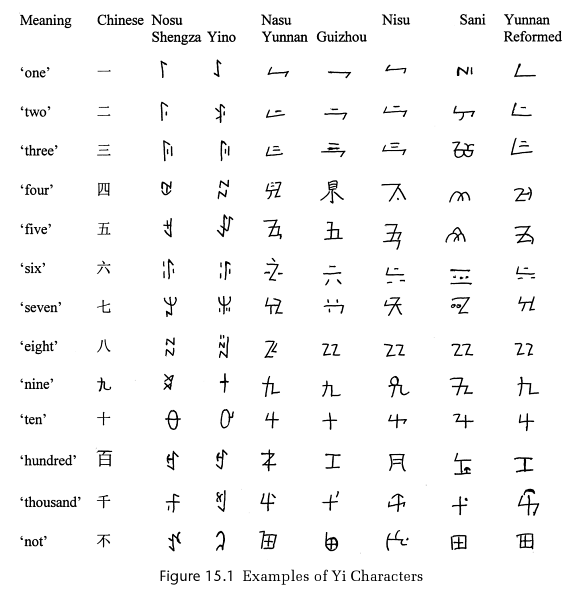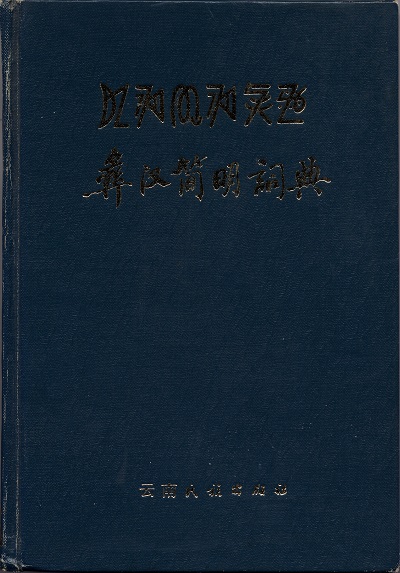Sani Script
撒尼彝文
Introduction
The Sani Yi script is a variety of the Yi writing system used by the Sani people 撒尼人 of central Yunnan province (primarily Shilin Yi Autonomous County 石林彝族自治县 and Yiliang County 宜良县) to write the Sani language 撒尼语 (officially considered part of the Southeastern Yi dialect 彝语东南部方言). This script is related to, but not unifiable with, the Liangshan Yi (Nuosu) script that has been standardized in the Unicode Standard as the "Yi script". No proposal to encode the Sani Yi script in Unicode has yet been made, but these pages are intended to help with any future effort to encode this script.
Background Information
Bradley 2011
The Yi are an officially recognized national minority of nearly 8 million people in southwestern China. Like many other minorities in China, the category Yi includes distinct groups who speak a very wide range of related languages. In the case of the Yi, these sixty or more languages are all in the Ngwi (formerly known as Loloish) branch of the Tibeto-Burman language family. ... Four of these languages of the Yi nationality have distinct writing systems: Nosu [i.e. the "Yi script" in Unicode], Nasu, Nisu, and Sani. All four use the same logographic principles as Chinese writing and a few Chinese characters. Otherwise, these writing systems are very different from Chinese and to a lesser degree from each other.
From 1973 on, orthographic reforms for the Yi writing systems took place separately in the three main provinces where the Yi languages are spoken: Yunnan, Sichuan, and Guizhou. The process has been top-down language planning, run by leaders and language workers from the Yi communities of each province. In addition, all four traditional Yi scripts continue in use, mainly by traditional male religious practitioners (hereafter "shamans") and for scholarly purposes, though their use is declining.
Of the Yi groups with distinct writing systems, the Nosu are the Northern Yi, the Nasu are the Eastern Yi, the Nisu are the Southern Yi, and the Sani are the Southeastern Yi. There are many other languages without scripts classified in one or other of these four clusters. Some other groups within the Yi nationality have used Nasu or Nisu script to represent their own languages.

Sani is the main language of the Yi nationality in Shilin "stone forest" County, southeast of Kunming. The autonym of this group is Ni; Sani is a Chinese exonym containing the first syllable sa, which is very widespread in Chinese names for Yi groups around Kunming. Sani is also spoken in a number of surrounding counties by a total of about 120,000 people. The Shilin County government promotes the use of traditional Sani logographic characters and research on Sani topics, notably the story of Ashima, a Sani princess who wanted to marry a commoner. There are two dictionaries, one by a French Catholic missionary, Vial (1909), using a font restricted to 450 characters for cost reasons, and Jin (1984), representing a different dialect with over 1,300 handwritten head entry characters and some alternative forms.
— David Bradley, "Problems in Orthography Development for the Yi in China"; in Handbook of Language and Ethnic Identity: The Success-Failure Continuum in Language and Ethnic Identity Efforts (Oxford University Press, 2011) v. 2 pp. 180-191
Harrell 2013
The Chinese government has developed educational materials in the various Yi dialects and vernaculars (Bradley 1987:82), but the government-published 1984 Sani-Chinese dictionary (Yi-Han Dictionary 1984) using traditional Yi orthography and phonetic transcription is not used in Sani schools.32
32. The entries in the Yi-Han Dictionary (1984) are in Sani script, then phonetics, with definitions in Chinese. There is also a Chinese-SDani index. Sani have demonstrated to me their ability to use this dictionary, but it is virtually unavailable to them, and is not widely used in other research.
— Stevan Harrell, Cultural Encounters on China's Ethnic Frontiers (University of Washington Press, 2013) p. 174
Sani-Chinese Dictionary
I have created a scan font for the Sani Yi script based on the hand-written characters given in Yí-Hàn Jiǎnmíng Cídiǎn 彝汉简明词典 [Concise Yi-Chinese Dictionary] (Kunming: Yunnan Minzu Chubanshe, 1984). You may download this font from here, but you do not need to have this font installed on your system to view the Sani characters on this site as a web font (WOFF) version will be automatically downloaded and used if necessary.

The Sani-Chinese dictionary has 1,051 head entries, representing 943 distinct phonetic syllables. Most head entries correspond to a unique syllable, but in some cases the same syllable may have two or more head entries. In addition, some head entry characters have multiple readings. 193 of the head entries have between one and eight alternative character forms given in brackets (some alternative character forms are the main character for a different head entry). Discounting duplicate entries for alternative glyph forms, there are a total of 1,389 distinct character forms in the dictionary, 1,051 for head entries and 338 for alternative glyph forms. There is also an iteration mark, which is not given a separate entry in the dictionary.
The following pages relating to the characters in the Sani-Chinese dictionary are available:
Yi Script

